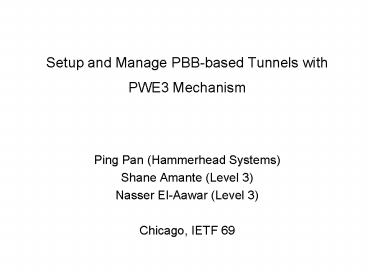Setup and Manage PBB-based Tunnels with PWE3 Mechanism - PowerPoint PPT Presentation
Title:
Setup and Manage PBB-based Tunnels with PWE3 Mechanism
Description:
Setup and Manage PBB-based Tunnels with PWE3 Mechanism Ping Pan (Hammerhead Systems) Shane Amante (Level 3) Nasser El-Aawar (Level 3) Chicago, IETF 69 – PowerPoint PPT presentation
Number of Views:67
Avg rating:3.0/5.0
Title: Setup and Manage PBB-based Tunnels with PWE3 Mechanism
1
Setup and Manage PBB-based Tunnels with PWE3
Mechanism
- Ping Pan (Hammerhead Systems)
- Shane Amante (Level 3)
- Nasser El-Aawar (Level 3)
- Chicago, IETF 69
2
What Problem are We Trying to Solve?
Aggregator
Ethernet Circuits in Mac-in-Mac
Encapsulation (dotted red lines)
PBB Tunnels (green tubes)
Ethernet VLAN Circuits (solid red lines)
- Conditions
- All-Ethernet network
- The access/aggregation nets are Q-in-Q
- The core is PBB-based
How to aggregate Ethernet flows into PBB tunnels?
?
3
Observation
- Due to operational reasons, the carriers have a
good reason in deploying MAC-in-MAC Ethernet core - Interconnecting Q-in-Q access networks with
MAC-in-MAC core - Due to operational reasons, MPLS LERs may not be
desirable to be used at the edge right now - Network operation may take a while to migrate
baby steps! - There are ways to setup edge-to-edge tunnels
- Existing practice static configuration
- Other proposals dynamic signaling protocols etc.
- Outside of the scope of our proposal
- The scenario is almost identical to that PWE3 has
a solution for - Aggregating ACs through PSN tunnels
- Instead of PW header with label, its Mac-in-Mac
header
4
What does the header look like?
ProviderBackboneBridge (PBB) frame format
Provider Bridge (PB) frame format
Customer frames
Payload
Payload
Payload
Ethertype
Ethertype
Ethertype
C-VID
C-VID
C-VID
C-Tag
Ethertype
Ethertype
Ethertype
C-SA
S-VID
S-VID
S-Tag
802.1
C-DA
Ethertype
Ethertype
C-SA
C-SA
802.1Q
C-DA
C-DA
I-SID
802.1ad
Ethertype
Same formatand Ethertype as an S-Tag
B-VID
C-SA Customer Source MAC address C-DA
Customer Destination MAC address VID VLAN
ID C-VID Customer VID (12 bits) S-VID Service
VID (12 bits) I-SID Service ID (24 bits) B-VID
Backbone VID (12 bits) B-DA Backbone DA B-SA
Backbone SA
Ethertype
B-SA
B-DA
802.1ah
Mac-in-Mac Header
5
Our Proposal
- Target LDP (RFC4447)
- FEC 129
- Encode Mac-in-Mac data in AII and AGI
Aggregator
Ethernet Circuits in Mac-in-Mac Encapsulation
PBB Tunnels
Ethernet VLAN Circuits
6
Operation Overview
Aggregator
A
B
IP-B MAC-B I-SID-B B-VID-B
IP-A MAC-A I-SID-A B-VID-A
- There are PSN tunnels interconnecting node A and
B - Operators configure IP, I-SID and B-VID etc. at
edge - From node A, send Label Mapping message to node B
with - SAII MAC-A, I-SID-A, B-VID-A
- TAII MAC-B, I-SID-B, B-VID-B
- Upon reception, run the standard RFC4447 on Node
B, then A - Program the data path for encapsulation and
aggregation - Ethernet flows will go through the PBB networks
7
What to be standardized?
- New AII Type
- A new AII format
8
In Conclusion
- PBB is a viable option for Ethernet deployment at
core - Aggregating Ethernet VLAN circuits over the core
is important - PWE3 has defined a simple mechanism for data
aggregation at network edge - Simple means that there is no need for
extensive IP routing etc. - By allocating a new AII Type (and associated
format), we can achieve Ethernet circuit
aggregation over PBB networks - Please consider this as a WG document































